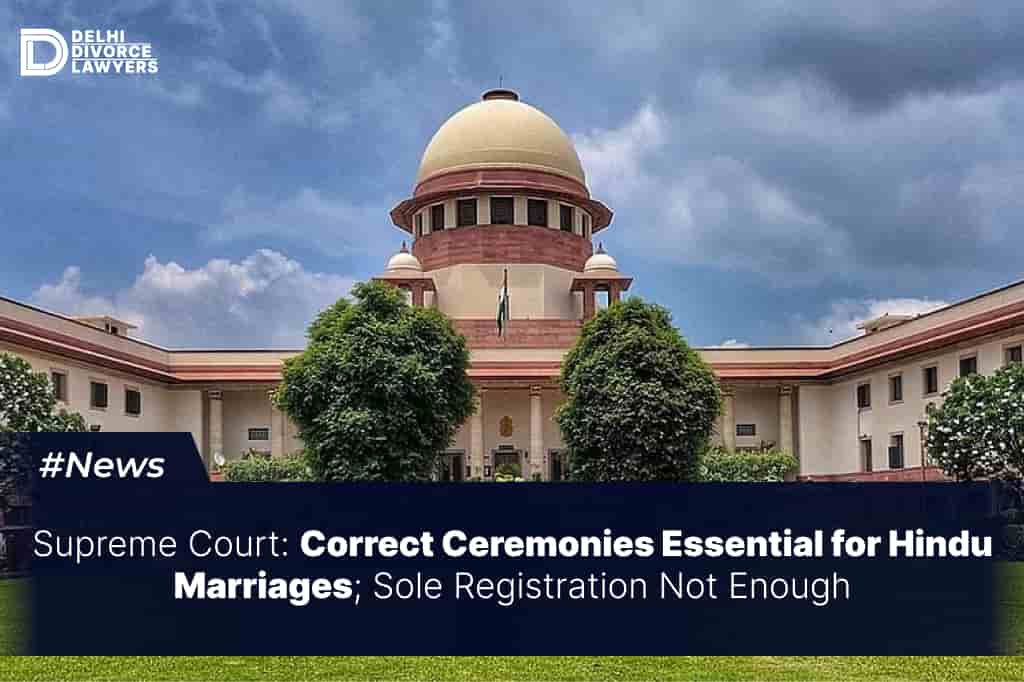In a recent judgment, the Supreme Court provided valuable clarifications regarding the legal obligations and significance of Hindu marriages under the Hindu Marriage Act of 1955. The Court underscored the necessity for adherence to the prescribed rituals and customs, including the saptapadi, highlighting the pivotal role of tangible evidence of these ceremonies, especially in contested scenarios. Justices BV Nagarathna and Augustine George Masih, members of the bench, commented:
“Where a Hindu marriage is not performed in accordance with the applicable rites or ceremonies such as saptapadi when included, the marriage will not be construed as a Hindu marriage. In other words, for a valid marriage under the Act, the requisite ceremonies have to be performed and there must be proof of performance of the said ceremony when an issue/controversy arise. Unless the parties have undergone such ceremony, there would be no Hindu marriage according to Section 7 of the Act and a mere issuance of a certificate by an entity in the absence of the requisite ceremonies having been performed, would neither confirm any marital status to the parties nor establish a marriage under Hindu law.”
The Court clarified that while registering a Hindu marriage under Section 8 of the Hindu Marriage Act documents the marriage, it doesn’t validate it if the ceremony didn’t comply with the conditions specified in Section 7 of the Act, which delineates the requisites for a legally recognized Hindu marriage ritual.
“If there has been no marriage in accordance with Section 7, the registration would not confer legitimacy to the marriage. We find that the registration of Hindu marriages under the said provision is only to facilitate the proof of a Hindu marriage but for that, there has to be a Hindu marriage in accordance with Section 7 of the Act inasmuch as there must be a marriage ceremony which has taken place between the parties in accordance with the said provision. Although the parties may have complied with the requisite conditions for a valid Hindu marriage as per Section 5 of the Act in the absence of there being a “Hindu marriage” in accordance with Section 7 of the Act, i.e., solemnization of such a marriage, there would be no Hindu marriage in the eye of law.”
There cannot be no registration of a Hindu marriage if it has not been performed as per the custom
The Court added :
“In the absence of there being a valid Hindu marriage, the Marriage Registration Officer cannot register such a marriage under the provisions of Section 8 of the Act. Therefore, if a certificate is issued stating that the couple had undergone marriage and if the marriage ceremony had not been performed in accordance with Section 7 of the Act, then the registration of such marriage under Section 8 would not confer any legitimacy to such a marriage. The registration of a marriage under Section 8 of the Act is only to confirm that the parties have undergone a valid marriage ceremony in accordance with Section 7 of the Act. In other words, a certificate of marriage is a proof of validity of Hindu marriage only when such a marriage has taken place and not in a case where there is no marriage ceremony performed at all.”
The Court criticized marriages driven solely by “pragmatic considerations” that disregard traditional values. Underlining the sanctity of Hindu marriage, the Court portrayed it as a revered union forming the cornerstone of a new family, built upon mutual respect and collaboration between partners.
“In the absence of any solemnisation of a marriage as per the provisions of the Act, a man and a woman cannot acquire the status of being a husband and a wife to each other. In the above context, we deprecate the practice of young men and women seeking to acquire the status of being a husband and a wife to each other and therefore purportedly being married, in the absence of a valid marriage ceremony under the provisions of the Act such as in the instant case where the marriage between the parties was to take place later.”
The Court voiced concern over the increasing trend of couples assuming spousal roles without formal marriage ceremonies, emphasizing the sanctity of marriage within Indian culture. It encouraged young couples to contemplate the profound meaning of marriage prior to commitment, stressing that marriage transcends mere practical considerations, symbolizing a sacred bond between two individuals.
“In recent years, we have come across several instances where for “practical purposes”, a man and a woman with the intention of solemnisation of their marriage at a future date seek to register their marriage under Section 8 of the Act on the basis of a document which may have been issued as proof of ‘solemnisation of their marriage’ such as in the instant case. As we have already noted, any such registration of a marriage before the Registrar of Marriages and a certificate being issued thereafter would not confirm that the parties have ‘solemnised’ a Hindu marriage. We note that parents of young couples agree for registration of a marriage in order to apply for Visa for emigration to foreign countries where either of the parties may be working “in order to save time” and pending formalising a marriage ceremony. Such practices have to be deprecated. What would be the consequence, if no such marriage is solemnised at all at a future date? What would be the status of the parties then? Are they husband and wife in law and do they acquire such status in society?”
During the hearing of a petition brought forth by a wife seeking the relocation of divorce proceedings, the Court made these remarks. While the case was in progress, both the husband and wife reached a consensus to jointly submit an application asserting the invalidity of their marriage. They contended that no legitimate marriage ceremony had occurred, with a lack of adherence to customary rites or traditions. Nonetheless, due to “certain pressures and exigencies,” they felt compelled to acquire a solemnization certificate from the Vadik Jankalyan Samiti (Regd.). Consequently, they pursued registration under the Uttar Pradesh Registration Rule of 2017, leading to the issuance of a “Certificate of Marriage” by the Registrar of Marriages. Upon acknowledging the absence of a solemnized marriage, the Court declared the marriage null and void. Furthermore, the Court made several noteworthy observations:
Hindu Marriage a sacrament, not an event for “song-dance”, “wining-dining”
“A Hindu marriage is a samskara and a sacrament which has to be accorded its status as an institution of great value in Indian society. Therefore, we urge young men and women to think deeply about the institution of marriage even before they enter upon it and as to how sacred the said institution is, in Indian society. A marriage is not an event for ‘song and dance’ and ‘wining and dining’ or an occasion to demand and exchange dowry and gifts by undue pressure leading to possible initiation of criminal proceedings thereafter. A marriage is not a commercial transaction. It is a solemn foundational event celebrated so as to establish a relationship between a man and a woman who acquire the status of a husband and wife for an evolving family in future which is a basic unit of Indian society.
A Hindu marriage facilitates procreation, consolidates the unit of family and solidifies the spirit of fraternity within various communities. After all, a marriage is sacred for it provides a lifelong, dignity-affirming, equal, consensual and healthy union of two individuals. It is considered to be an event that confers salvation upon the individual especially when the rites and ceremonies are conducted. The customary ceremonies, with all its attendant geographical and cultural variations is said to purify and transform the spiritual being of an individual.”
Marriage ceremonies must be assiduously followed
“The Hindu Marriage Act, 1955 solemnly acknowledges both the material and spiritual aspects of this event in the married couple’s lives. Besides providing a mechanism for registration of marriages in order to confer the status of a married couple and acknowledge rights in personam and rights in rem, a special place is given to rites and ceremonies in the Act. It follows that the critical conditions for the solemnizing of a Hindu marriage should be assiduously, strictly and religiously followed. This is for the reason that the genesis of a sacred process cannot be a trivial affair. The sincere conduct of and participation in the customary rites and ceremonies under Section 7 of the Hindu Marriage Act, 1955 ought to be ensured by all married couples and priests who preside over the ceremony.”

